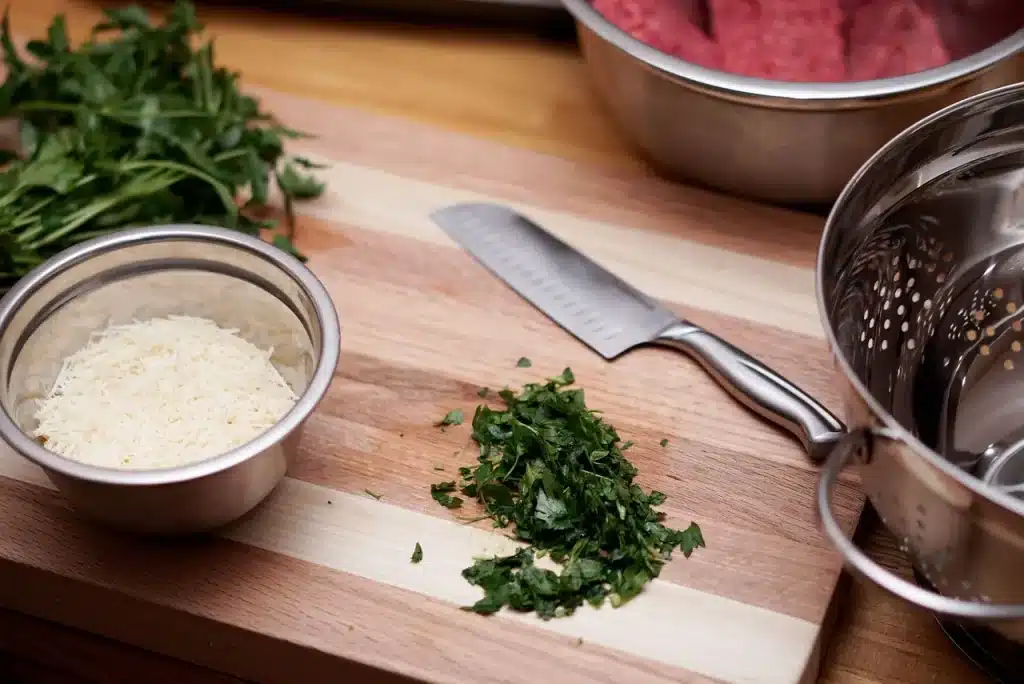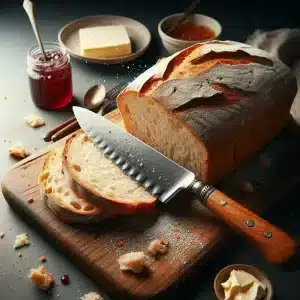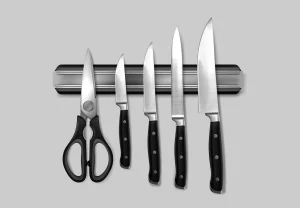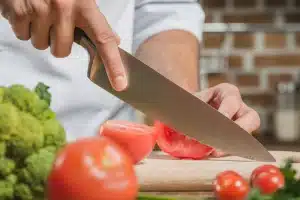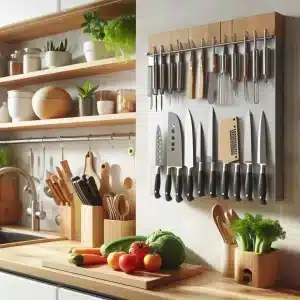When selecting the best knives for cutting meat, you should prioritize features like sharpness, durability, and versatility. A quality meat-cutting knife should have a sharp blade to easily slice through different types of meat without tearing the fibers. The material should be corrosion-resistant, ensuring longevity even with regular contact with moisture.
Additionally, the knife’s handle should offer a comfortable, non-slip grip to prevent accidents during heavy-duty cutting tasks. The knife should also have good weight distribution to allow for precision and ease of use during extended periods of cutting.
Types of knives for meat cutting
Chef’s Knife
The chef’s knife is versatile, with an 8-12 inch blade, ideal for chopping, slicing, and dicing a wide variety of foods, from vegetables to meats. It’s an essential tool in any kitchen due to its versatility, designed to handle almost any cutting task with ease.
Santoku Knife
The Santoku knife, 5-7 inches, is similar to a chef’s knife but shorter and with a wider blade. It excels in slicing, dicing, and mincing vegetables, meats, and fish. It’s a staple in Japanese cooking, designed for precision cuts, like:
- Sale!
 Out of stock
Kitchen Utensils
Out of stock
Kitchen UtensilsDamascus Laser Kitchen Knife Japanese Santoku Meat Cleaver Knife Fruit Cutting Chef Knife Cooking Knife Kitchen Accessories
Rated 0 out of 5$14.00 – $46.00 Select options This product has multiple variants. The options may be chosen on the product page
This Japanese-style Santoku knife is designed for both precision and heavy-duty tasks. With a beautifully patterned Damascus steel blade, it is not only sharp but also highly durable. The meat cleaver design allows it to handle large cuts of meat and bones with ease. However, the knife may feel too large for smaller, more detailed cutting tasks. Its weight ensures it’s excellent for tough cuts, but it may be heavy for prolonged use.
Paring Knife
The paring knife, with a 3-4 inch blade, is perfect for small, precise tasks like peeling fruits and vegetables or trimming fat. Its compact size makes it ideal for intricate work that requires more control than larger knives can provide, like:
- Sale!
 Out of stock
Kitchen Utensils
Out of stock
Kitchen Utensils3.5 inches Small Paring Knife for Chopping Vegetable Steak Cutting Peeling fruit German High Carbon Stainless Steel Fruit Knives
Rated 0 out of 5$34.00Original price was: $34.00.$14.00Current price is: $14.00. Select options This product has multiple variants. The options may be chosen on the product page
This compact 3.5-inch paring knife is perfect for detailed tasks like trimming fat or preparing small cuts of meat. Made from high-carbon stainless steel, it offers excellent sharpness and corrosion resistance. The small size ensures easy handling for precision tasks. However, its small blade may not be suitable for larger meat-cutting jobs. Its lightweight design makes it easy to use, but it lacks the heft needed for heavy-duty tasks.
Filleting Knife
A filleting knife, 6-11 inches, has a thin, flexible blade for delicate tasks like filleting fish or thinly slicing meats. It’s ideal for precision cuts, allowing the user to remove skin or bones without damaging the flesh.
Boning Knife
The boning knife has a 5-6 inch blade designed for removing bones from meat, poultry, or fish. Its thin, slightly curved blade allows it to work around bones with precision, making it indispensable for butchering tasks.
Butcher Knife
A butcher knife, typically 6-14 inches, is heavy and durable, designed for cutting through large pieces of meat and bones. Its broad, sturdy blade provides the heft needed for chopping and sectioning.
Cleaver
The cleaver is a large, heavy knife with a broad, rectangular blade. It’s used for chopping through bones and large cuts of meat. Its weight makes it ideal for heavy-duty kitchen tasks, especially butchering, like:
This stainless steel cleaver is designed for slicing meat, fish, and vegetables, making it a versatile addition to any kitchen. Its sharp, durable blade ensures clean cuts without tearing meat fibers. The ergonomic handle provides a comfortable grip, allowing for prolonged use. One downside is that it might feel too heavy for delicate cutting tasks. Nevertheless, it excels in heavy-duty chopping and meat preparation.
Carving Knife
The carving knife, with a long, thin blade (10-14 inches), is designed to slice thin, uniform pieces of meat, particularly from roasts or hams. Its narrow profile allows it to glide easily through meat, creating smooth, precise cuts.
Best knives for meat cutting: key features
Here are some key characteristics to consider when choosing the best knives for meat cutting:
1. Blade material: High-carbon stainless steel is ideal because it is durable, sharp, and resistant to corrosion. Japanese knives often use these materials for precision cutting.
2. Sharpness: A razor-sharp edge ensures clean cuts without tearing meat fibers.
3. Flexibility: Boning knives benefit from flexible blades, which allow for maneuvering around bones and joints.
4. Weight: Heavier knives, like cleavers, are useful for cutting through bones, while lighter knives are better for precision slicing.
5. Handle comfort: A comfortable, non-slip grip is essential for safe, extended use.
What to look for in a good meat-cutting knife
When selecting a good knife for meat cutting, there are several factors to keep in mind:
1. Blade length: Choose a knife with a blade length that suits your needs. Longer blades are ideal for slicing, while shorter blades provide more control for intricate tasks.
2. Balance and weight: A well-balanced knife ensures easier handling. Heavy knives are great for cutting through thick meat and bones, while lighter ones offer better precision.
3. Sharpness and edge retention: Opt for knives that maintain sharpness over time, reducing the need for frequent sharpening. High-carbon stainless steel and Damascus steel are known for retaining a sharp edge.
4. Durability: The knife should be made from high-quality materials like German or Japanese steel, known for their strength and long-lasting performance.
Frequently Asked Questions
1. What is the best knife for cutting meat?
A chef’s knife is the most versatile option for cutting meat, offering a good balance between weight, sharpness, and control. For tasks that require precision, such as deboning, a boning knife or a slicing knife is better suited.
2. How should I maintain my meat-cutting knife?
Regularly hone the blade to maintain sharpness and wash it by hand to prevent corrosion. Avoid putting knives in the dishwasher as this can dull the blade over time. Use a sharpening stone or professional sharpening service for deeper sharpening.
3. Are Japanese knives better for cutting meat?
Japanese knives, especially those made from high-carbon stainless steel or Damascus steel, are known for their sharpness and precision. They excel in tasks requiring fine cuts, but heavier Western knives may be better for cutting through bones or thick meat.
4. What is the difference between a chef’s knife and a cleaver?
A chef’s knife is versatile and designed for various tasks, including chopping, slicing, and dicing. A cleaver is heavier and better suited for cutting through bones or tough cuts of meat. Cleavers are ideal for heavy-duty butchering tasks.
5. Can I use the same knife for cutting meat and vegetables?
Yes, many chef’s knives or Santoku knives can be used for both meat and vegetables. However, it’s recommended to have separate knives for raw meat to prevent cross-contamination when preparing different types of food.

